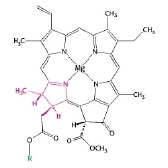|
|
 |

Get the scoop on IU faculty and staff news in the Oct. 8, 2010, issue of IU Home Pages.
|
|
|
 |

When leaves appear to turn from green to red or yellow, what autumn admirers are seeing isn't the changing of colors, exactly, but the loss of green contributed by chlorophyll, a pigment that helps plants capture light. When leaves are programmed to die, processes that maintain chlorophyll levels cease, and the remaining chlorophyll is (mostly) broken down. Some of these nutrients are reclaimed by the stems and branches, for use in the coming spring.
|
|
|
 |
Outstanding Women in Science Lecture
Thursday, Oct. 21
3-4 p.m.
Whittenberger Auditorium, IU Bloomington
MIT's Sossina Haile will give the talk, "Fuels from Sunlight, Water and Carbon Dioxide: A Thermochemical Approach." Haile says that one of humanity's greatest challenges is developing sustainable energy. More energy from sunlight strikes the earth in one hour than all of the energy consumed on the planet in one year. Haile and her colleagues at the California Institute of Technology have developed a unique thermochemical approach for converting water and carbon dioxide to storable fuels using the heat of the sun.
|
 |
 |
|
Scientist at Work: Dennis Peters

 For Indiana University Bloomington chemist Dennis Peters, there is one route to happiness: never stray from your passions, inspire those who will be your future, and thrive on the frustrations that help you learn from your mistakes. The Herman T. Briscoe Professor's ideology is familiar to his colleagues and former students. Peters says he discovered the joys of research as an undergraduate -- but only after joining the lab of Ernest H. Swift at the California Institute of Technology. Peters learned that the act of doing research motivated him -- despite the fact that he found the subject matter challenging.
Full Story
For Indiana University Bloomington chemist Dennis Peters, there is one route to happiness: never stray from your passions, inspire those who will be your future, and thrive on the frustrations that help you learn from your mistakes. The Herman T. Briscoe Professor's ideology is familiar to his colleagues and former students. Peters says he discovered the joys of research as an undergraduate -- but only after joining the lab of Ernest H. Swift at the California Institute of Technology. Peters learned that the act of doing research motivated him -- despite the fact that he found the subject matter challenging.
Full Story
|

An antibiotic typically used for treatment of spinal meningitis and Lyme disease may also be effective in alleviating the abnormal motor movements typical of Huntington's disease, scientists at Indiana University Bloomington say. Huntington's disease (HD) is a genetic neurodegenerative disorder whose symptoms often become noticeable when a person reaches middle age. Involuntary muscle movements are characteristic of HD while cognitive deterioration resulting in dementia or memory loss occurs as the disease progresses. At the molecular level, there is an excess of extracellular glutamate, an amino acid that functions in food metabolism as well as in communication between brain cells. The high concentration of glutamate may be causing damage to neurons in the forebrain, where most degeneration occurs.
Full Story

Researchers at the Indiana University Melvin and Bren Simon Cancer Center have published the first report using imaging to show that changes in brain tissue can occur in breast cancer patients undergoing chemotherapy. The cognitive effects of chemotherapy, often referred to as "chemobrain," have been known for years. However, the IU research is the first to use brain imaging to study women with breast cancer before and after treatment, showing that chemotherapy can affect gray matter. The researchers reported their findings in the October 2010 edition of Breast Cancer Research and Treatment.
Full Story

An Indiana University School of Medicine congenital heart surgeon and inventor has been awarded $2.1 million to continue development of a heart pump being designed to combat a form of congenital heart disease that is the leading cause of death from birth defects in the first year of a child's life. Mark Rodefeld, M.D., an associate professor of surgery at the IU medical school, will use funding from the National Institutes of Health's National Heart, Lung, and Blood Institute to further develop a new type of blood pump that uses a spinning disk to pull blood from the veins and push it into the arteries of children and adults born with only one functioning heart ventricle.
Full Story

The red, metal-laden sludge that escaped a containment pond in Hungary in early October could be made less toxic with the help of carbon sequestration, says an Indiana University Bloomington geologist who has a patent pending on the technique. The bauxite residue now covers 40 square kilometers south of the Danube River, and has caused the deaths of eight Hungarians and injured at least 150. The residue also has caused the extinction of life in a local river and as yet unknown environmental damage elsewhere. While human deaths in the wake of the disaster may have been strictly a result of the containment failure, injuries have mostly been attributed to the chemical properties of the sludge, whose high pH (between 11 and 13) can quickly damage and kill living cells.
Full Story

A $2 million grant from the National Science Foundation to Indiana University-Purdue University Indianapolis is targeted to boost the number of students graduating with bachelor's degrees in science, technology, engineering and mathematics by 10 percent. The funding is designed to encourage more students, including those who begin their college education in a local community college, to embark on careers in science, technology, engineering and mathematics.
Full Story

A new study by researchers at Indiana University and several other institutions shows that streams in the Midwest contain materials from corn that has been genetically engineered to be toxic to insect pests -- as long as six months after the corn was harvested. The study by Todd V. Royer, associate professor in the IU School of Public and Environmental Affairs, and colleagues at the University of Notre Dame and other institutions was published last month in Proceedings of the National Academy of Sciences.
Full Story

The September 21, 2010, issue of IU Discoveries featured biophysicist James Glazier and his recent work on the properties of bubbles. Also included were stories about sequencing the cacao genome, a chemical tool that turns off when exposed to UV light, an IU researcher's scholarship on Isaac Newton, the formation of a new scientific field called environmental genomics, and grants to the Bloomington Drosophila Stock Center and the Low Energy Neutron Source project.
Full Story
 |
 |
|
|
 |
Some recent titles by IU researchers
"A simple and general method for determining the protein and nucleic acid content of viruses by UV absorbance," Virology, Nov. 25, 2010, by J.Z. Porterfield and A. Zlotnik
"Gene copy-number polymorphism in nature," Proceedings of the Royal Society B, Nov. 7, 2010, by D.R. Schrider and M.W. Hahn
"Temporal and spatial integration of face, object, and scene features in occipito-temporal cortex," JBrain Cognition, Nov. 2010, by T.W. James, E. Huh, and S. Kim
"Single-port laparoscopic right hemicolectomy: a safe alternative to conventional laparoscopy," Diseases of the Colon and Rectum, Nov. 2010, by J.A. Waters, M.J. Guzman, A.D. Fajardo, D.J. Selzer, E.A. Wiebke, B.W. Robb, and V.V. George
|
|
|
 |
|
|
|
 |
 The Indiana University Kokomo community and beyond can now tune in and listen to their favorite songs on Radio Free Kokomo, a 24-hour online streaming radio station organized and produced by students on campus. Listeners can tune in by clicking on a streaming link.
The Indiana University Kokomo community and beyond can now tune in and listen to their favorite songs on Radio Free Kokomo, a 24-hour online streaming radio station organized and produced by students on campus. Listeners can tune in by clicking on a streaming link.
|
|







